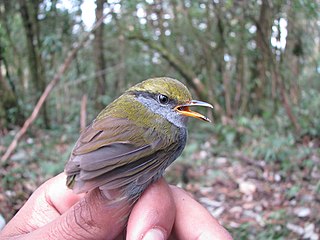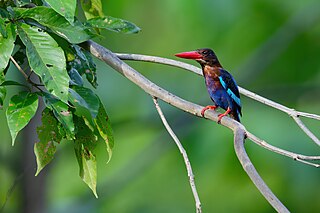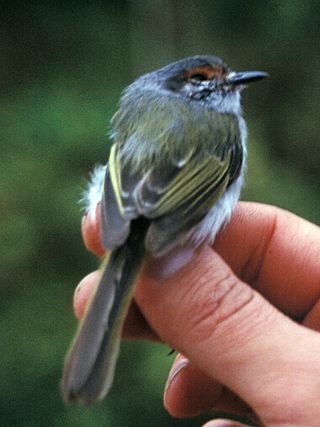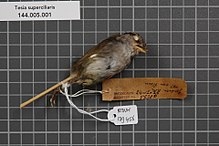Old World warblers are a large group of birds formerly grouped together in the bird family Sylviidae. They are not closely related to the New World warblers. The family held over 400 species in over 70 genera, and were the source of much taxonomic confusion. Two families were split out initially, the cisticolas into Cisticolidae and the kinglets into Regulidae. In the past ten years they have been the subject of much research and many species are now placed into other families, including the Acrocephalidae, Cettiidae, Phylloscopidae, and Megaluridae. In addition some species have been moved into existing families or have not yet had their placement fully resolved. A smaller number of warblers, together with some babblers formerly placed in the family Timaliidae and the parrotbills, are retained in a much smaller family Sylviidae.

The Javan rhinoceros, also known as the Javan rhino, Sunda rhinoceros or lesser one-horned rhinoceros, is a very rare member of the family Rhinocerotidae and one of five extant rhinoceroses. It belongs to the Rhinoceros genus and has a mosaic, armour-like skin, is 3.1–3.2 m (10–10 ft) long and 1.4–1.7 m (4.6–5.6 ft) high. Its horn is usually shorter than 25 cm (9.8 in). Only adult bulls have horns. The Javan rhinoceros ranged from the islands of Java and Sumatra throughout Southeast Asia and into India and China. Today, it is critically endangered, with only one known population in the wild, and no individuals in captivity. It is one of the rarest large mammals on Earth, with a population of approximately 74 in Ujung Kulon National Park at the western tip of Java in Indonesia. The Javan rhinoceros population in Vietnam's Cat Tien National Park was declared to be locally extinct in 2011. The decline of Javan rhinoceros is attributed to poaching, primarily for its horns, which are highly valued in traditional Chinese medicine, fetching as much as US$30,000 per kg on the black market. As European presence in its range increased, trophy hunting also became a serious threat. Loss of habitat, especially as the result of wars, such as the Vietnam War, has also contributed to its decline and hindered recovery. The remaining range is within one nationally protected area, but it is still at risk from poachers, disease, and loss of genetic diversity leading to inbreeding depression. Ujung Kulon National Park is also a UNESCO World Heritage Site.

The Javan green magpie is a passerine bird in the crow family, Corvidae. This critically endangered species is endemic to montane forests on the Indonesian island of Java. It formerly included the Bornean green magpie as a subspecies, in which case the "combined" species was known as the short-tailed magpie.

The yellow-bellied warbler is a species of bush warbler. It was formerly included in the "Old World warbler" assemblage.

The chestnut-headed tesia is a small insectivorous songbird formerly of the "Old World warbler" family but nowadays placed in the bush warbler family (Cettiidae).

The tesias are a genus, Tesia, of Old World warbler. Though once included in the large family Sylviidae, more recent research placed it within a new family, Cettiidae. The four species inhabit undergrowth of montane forest in South and Southeast Asia, where they are resident or short-range migrants. They have longish legs and appear tailless, with (seemingly) only 8 rectrices. Their simple songs are fairly loud, and their nests are typically ball-shaped. Their name is derived from Tisi, the Nepalese name for the grey-bellied tesia.

The grey-bellied tesia is a species of warbler in the family Cettiidae.

The russet-capped tesia is a species of Old World warbler in the family Cettiidae. The scientific name commemorates British colonial administrator and zoological collector Alfred Hart Everett.

The slaty-bellied tesia is a species of warbler in the family Cettiidae.

Ptychadena superciliaris is a species of frog in the family Ptychadenidae. It is found in Ivory Coast, Ghana, Guinea, Liberia, and Sierra Leone. Its natural habitats are subtropical or tropical moist lowland forest and intermittent freshwater marshes. It is threatened by habitat loss.

The yellow-billed tern is a small seabird found in South America. It is a species of tern in the family Laridae. It is found in Argentina, Bolivia, Brazil, Colombia, Ecuador, French Guiana, Guyana, Panama, Paraguay, Peru, Suriname, Trinidad and Tobago, Uruguay, and Venezuela. Its natural habitats are rivers, swamps, and freshwater lakes.

The Javan kingfisher, sometimes called the blue-bellied kingfisher or Java kingfisher, is a medium-sized kingfisher endemic to the Indonesian islands of Java and Bali.

The yellow-browed camaroptera is a species of bird in the family Cisticolidae. It is found in Angola, Benin, Cameroon, Central African Republic, Republic of the Congo, Democratic Republic of the Congo, Ivory Coast, Equatorial Guinea, Gabon, Ghana, Guinea, Liberia, Nigeria, Sierra Leone, Togo, and Uganda. Its natural habitats are subtropical or tropical moist lowland forests and subtropical or tropical moist shrubland.

The superciliaried hemispingus is a species of bird in the family Thraupidae.

The cream-browed white-eye, also known as the cream-browed ibon or yellow-browed white-eye, is a species of bird in the family Zosteropidae. It is endemic to the Lesser Sunda Islands. Its natural habitat is subtropical or tropical moist montane forest.

The yellow-throated bush sparrow, also known as the yellow-throated petronia, is a species of bird in the sparrow family Passeridae. It is found in south-central and southern Africa in its natural habitats of subtropical or tropical dry forests, dry savanna, and subtropical or tropical dry shrubland.

The rufous-browed tyrannulet is a species of bird in the family Tyrannidae.

The Javan warty pig, also called Javan wild pig, is an even-toed ungulate in the family Suidae. It is endemic to the Indonesian islands Java and Bawean, and is considered extinct on Madura. It is listed as Endangered on the IUCN Red List since 1996.

The Lesser Sundas deciduous forests is a tropical dry forest ecoregion in Indonesia. The ecoregion includes the islands of Lombok, Sumbawa, Komodo, Flores, and Alor, along with the many adjacent smaller islands.


















